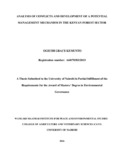| dc.description.abstract | This study sought to assess the common types of forest resource-based conflicts in Kenya and develop a potential management framework. Forest resource-based conflicts are still rampant despite devolution of forest governance and recognition of participatory forest management in the constitution of Kenya, 2010 and the Forest act, 2005. The objectives of the study were to assess the types of forest resource-based conflicts, the existing management measures and their challenges as well as to determine possible management strategies. The study focused on three study areas, Kereita, Rumuruti and Kaptagat forests. A total of 242 semi-structured questionnaires were administered to forest adjacent community members, which were complimented with key informant interviews and Focus group discussions for a better understanding of the conflict issues. The main conflicts identified included, human-wildlife conflicts, conflicts over inadequate benefit sharing of forest resources and conflicts arising from the inadequate involvement of forest-adjacent communities in forest management and decision making. These conflicts mainly arose due to inequity in resource allocation, inadequate information sharing and perceived corruption in forest management. Forest sector stakeholders managed the conflicts mainly through community sensitization, mediation and arbitration. However, these strategies were not adequately practiced. The study concluded that a wide range of strategies are necessary in management of forest resource-based conflicts. The conflict management system requires active involvement of all forest actors in the formulation and implementation process to meet targets, consultation of parties, equitable resource allocation, balancing interests and capacity building of the weakest stakeholders to reduce power imbalances. Major recommendations arose from the study: KFS and the Ministry of
xi
Environment and Natural Resources with support from other actors, must make use of the ongoing forest and wildlife policy reforms to integrate conflict management strategies; KFS should seek internal and external funding sources to strengthen forums for discussion and facilitate information sharing and forestry education; and The National government should focus building on empowering local leaders who have the potential to mediate in conflicts | en_US |



